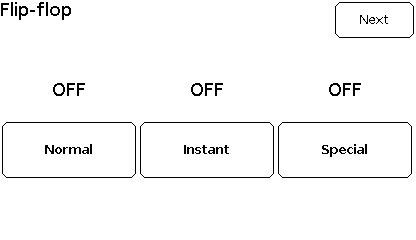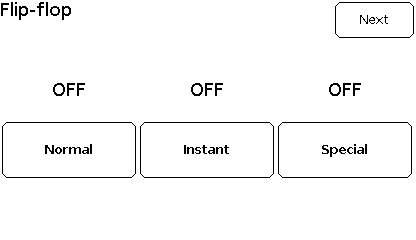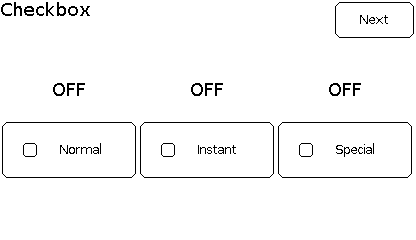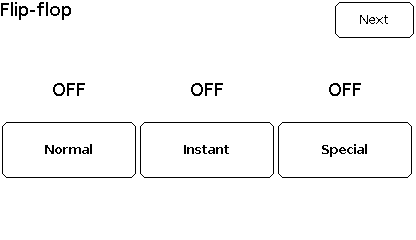Flip-flop button¶
The flip-flop button is an input element and a variant of the button which keeps the state, off or on.

Configure¶
Warning
Ensure the GUI library is included and initialised according to the configuration procedure
Button myButton(&myGUI);
The constructor Button() creates a flip-flop button and sets the link to the GUI myGUI.
1 2 3 | |
dDefine()- defines the flip-flop button with vector coordinates.
The required parameters are
-
The first line specifies the vector coordinates: top-left coordinates x-y then width and height in pixels;
-
The second line contains the item, here built with
setItem()with an index and a text.
The optional parameters are
- The third line is optional: the size of the font, by default
fontSizeAutomaticfor automatic.
By default, the button is standard and enabled according to the GUI setting, with value set to zero.
Then,
myButton.setOption(optionFlipFlop);
myButton.setState(stateEnabled);
myButton.setValue(false);
setOption()- needs to be set to
optionFlipFloportrueto turn the button into a flip-flop button. setState()- defines whether touch is enabled for the element.
Select
-
stateDisabledorfalsefor touch disabled; -
stateEnabledortruefor touch enabled.
Note
Use literals instead of values for upward compatibility.
Default is false for touch disabled.
setValue()- sets the initial value of the flip-flop element:
-
falsefor flip-flop turned off; -
truefor flip-flop turned on.
Use¶
myButton.draw();
bool result = myButton.check();
uint32_t index = myButton.getIndex();
bool result = myButton.getValue();
draw()- displays the button.
check()- polls the touch controller and returns
trueis the button is pressed.
An optional parameter defines the mode of how the element is checked:
-
checkNormalfor normal check mode; -
checkInstantfor instant check mode; -
checkSpecialfor special check mode.
Default mode is normal check mode.
In normal check mode, the element requires the finger to be hold for a momenet and raises the event when the finger is released. Additionally, the element goes through a cinematic sequence.

From off to on: start, press, hold, release
In instant check mode, the element raises the event when the finger touches the element. No cinematic sequence is performed.

From off to on: start, press
In special check mode, the element raises the event when the finger is released from the element. A simplified cinematic sequence is performed.

From off to on: start, press, release
The technical note Optimise GUI speed provides more details on the cinematic sequences of each check mode.
getIndex()- returns the index of the button, set at
dDefine() - .
getValue() gets the value of the flip-flop element:
-
falsefor flip-flop turned off; -
truefor flip-flop turned on.
Example¶
This is the core of the code from example GUI_Button.ino.

void displayFlipFlop()
{
myScreen.setOrientation(myOrientation);
uint16_t x, y, dx, dy;
x = myScreen.screenSizeX();
y = myScreen.screenSizeY();
dx = x / 3;
dy = y / 4;
// myGUI.begin();
myGUI.delegate(false);
myGUI.dLabel(0, 0, x, dy, "Flip-flop ", myColours.black, myColours.white, -1, 1, fontLarge);
Text myText1(&myGUI);
myText1.dDefine(dx * 0, dy, dx * 1, dy, 0, 0, fontLarge);
myText1.draw("OFF");
Text myText2(&myGUI);
myText2.dDefine(dx * 1, dy, dx * 1, dy, 0, 0, fontLarge);
myText2.draw("OFF");
Text myText3(&myGUI);
myText3.dDefine(dx * 2, dy, dx * 1, dy, 0, 0, fontLarge);
myText3.draw("OFF");
Button myFlipFlop1(&myGUI);
myFlipFlop1.dDefine(dx * 0, dy * 2, dx * 1, dy, setItem(0x0001, "Normal"), fontMediumBold);
myFlipFlop1.setOption(optionFlipFlop);
myFlipFlop1.setState(stateEnabled);
myFlipFlop1.draw();
Button myFlipFlop2(&myGUI);
myFlipFlop2.dDefine(dx * 1, dy * 2, dx * 1, dy, setItem(0x0002, "Instant"), fontMediumBold);
myFlipFlop2.setOption(optionFlipFlop);
myFlipFlop2.setState(stateEnabled);
myFlipFlop2.draw();
Button myFlipFlop3(&myGUI);
myFlipFlop3.dDefine(dx * 2, dy * 2, dx * 1, dy, setItem(0x0002, "Special"), fontMediumBold);
myFlipFlop3.setOption(optionFlipFlop);
myFlipFlop3.setState(stateEnabled);
myFlipFlop3.draw();
drawNext();
myScreen.flushFast();
myGUI.delegate(true);
while (!checkNext())
{
if (myFlipFlop1.check())
{
myText1.draw(myFlipFlop1.getValue() ? "ON" : "OFF");
}
else if (myFlipFlop2.check(checkInstant))
{
myText2.draw(myFlipFlop2.getValue() ? "ON" : "OFF");
}
else if (myFlipFlop3.check(checkSpecial))
{
myText3.draw(myFlipFlop3.getValue() ? "ON" : "OFF");
}
else
{
hV_HAL_delayMilliseconds(10);
}
}
}